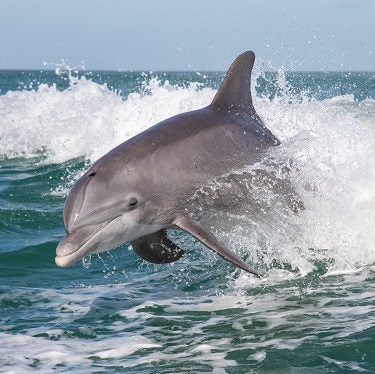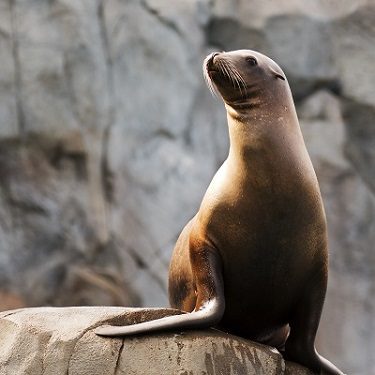Marine Life Encyclopedia
Marine Mammals
Sperm Whale
Physeter macrocephalus
Distribution
Worldwide in tropical to polar latitudes
eCOSYSTEM/HABITAT
Open ocean (pelagic); deep diver
FEEDING HABITS
Active predator
TAXONOMY
Suborder Odontoceti (toothed whales), Family Physeteridae (sperm whales)
Sperm whales have several specialized physical characteristics that aid in this predatory behavior. They have large conical teeth for ensnaring their preferred prey. Like most active predators, they have large brains and in fact, the sperm whale has the largest brain of any animal on the planet. They also have the most powerful sonar of any animal, which they use to find their prey in the dark deep sea. Finally, they have an ability to dive to incredible depths (up to 1000 meters) and stay down for incredible lengths of time (up to two hours), both abilities increasing their likelihood of finding prey. As a result of their deep-sea behaviors, sperm whales typically live in waters of several thousand meters deep and are rarely seen along the coast except in areas where deep trenches or underwater canyons approach the shore.
The sperm whale’s very large brain and specialized sonar organ (called a melon) contribute to its characteristic block-shaped head. It is the only whale that has that shaped head and is typically quite easy to identify. The body is generally uniformly grey. The sperm whale’s lifecycle is very similar to that of humans. Individuals reach sexual maturity in their teenage years, and females reproduce until they reach their forties and go on to live into their seventies. Sperm whales give birth to only one calf at a time, and at birth, baby Sperm Whales are enormous – over 13 feet (4 m) long. Because calves cannot undertake the deep, long dives that their mothers do, groups of mothers form tight bonds and share the responsibility of protecting calves at the surface. While one or more mothers dive, others stay with at the surface with the young.
150 years of commercial whaling for sperm whales cut their numbers at least in half, and some scientists estimate that whaling reduced the population by 75% or more. During a time when whale oil was a primary energy/lighting source in the U.S. and Europe, sperm whale oil was some of the highest quality and highest volume per whale of any species. Though whaling has all but ceased since 1988, sperm whales have not yet fully recovered from this cruel practice and are still considered vulnerable to extinction by expert scientists. They have, however, recovered more significantly than the other large whales and are the most common large whale in the ocean today. It is difficult to obtain accurate numbers of sperm whales in the wild, so it is equally difficult to determine if populations are increasing or decreasing, but today’s primary threats include accidental entanglement in fishing gear, chemical pollution, and noise pollution. Several countries around the world have offered sperm whales some or extensive legal protection.
Fun Facts About Sperm Whales
1. Sperm whales are the largest of all toothed whales and can grow to a maximum length of 52 feet (15.8 m) and weight of 90,000 pounds (40 metric tons), with males growing much larger than females.
2. Sperm whales live for up to 60 years.
3. Sperm whales have one of the widest distributions of all marine mammals, living everywhere from the Arctic to the Antarctic.
4. Sperm whales are named after the spermaceti – a waxy substance that was used in oil lamps and candles – found on their heads.
5. Sperm whales are known for their large heads that account for one-third of their body length.
6. Sperm whales can stay underwater for up to 60 minutes at a time.
7. Sperm whales can dive more than 10,000 feet (3,048 m) in search of their preferred prey, which includes squid, sharks and fish.
8. Sperm whales eat up to 3.5 percent of their body weight in food every day.
9. Female sperm whales form lasting relationships with other females in their family and create social groups around these bonds. Males, on the other hand, leave their matriarchal groups between 4 and 21 years old to join “bachelor schools” before eventually leading solitary lives in their later years.1
Engage Youth with Sailors for the Sea
Oceana joined forces with Sailors for the Sea, an ocean conservation organization dedicated to educating and engaging the world’s boating community. Sailors for the Sea developed the KELP (Kids Environmental Lesson Plans) program to create the next generation of ocean stewards. Click here or below to download hands-on marine science activities for kids.
References:
Get Involved

Donate Today
SUPPORT OUR WORK TO PROTECT THE OCEANS BY GIVING TODAY
With the support of more than 1 million activists like you, we have already protected nearly 4 million square miles of ocean.

TAKE ACTION NOW
Support policy change for the oceans
Decision-makers need to hear from ocean lovers like you. Make your voice heard!

VISIT OUR ADOPTION CENTER
SYMBOLICALLY ADOPT AN ANIMAL TODAY
Visit our online store to see all the ocean animals you can symbolically adopt, either for yourself or as a gift for someone else.

DOWNLOAD OCEAN ACTIVITIES
HELP KIDS DISCOVER OUR BLUE PLANET
Our free KELP (Kids Environmental Lesson Plans) empower children to learn about and protect our oceans!




